Evaluating Training & Development in Abu Dhabi Semi-Govt Orgs
VerifiedAdded on 2023/04/22
|17
|4106
|265
Project
AI Summary
This project proposal investigates the importance of training and development within semi-government organizations in Abu Dhabi, UAE. It explores internal and external factors influencing training, analyzes training practices and policies, and examines the impact of training and development programs on employee and organizational performance. The research employs a descriptive research design and mixed data collection methods, guided by positivism research philosophy and a deductive research approach. The proposal addresses ethical considerations, potential risks, and expected outcomes, aiming to provide insights into optimizing training and development strategies within the UAE's semi-government sector to enhance human resource capabilities and overall organizational effectiveness. Desklib provides access to similar project proposals and solved assignments for students.
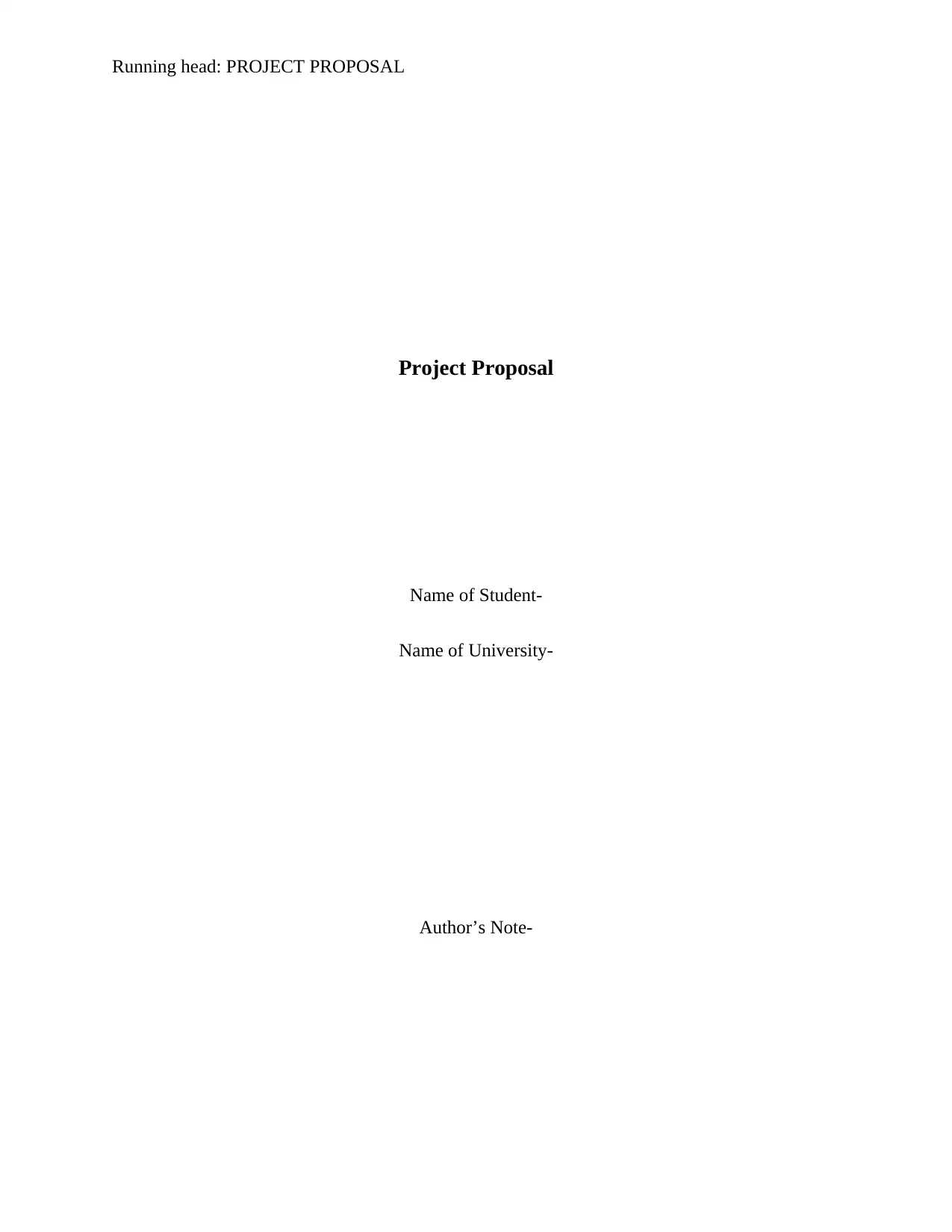
Running head: PROJECT PROPOSAL
Project Proposal
Name of Student-
Name of University-
Author’s Note-
Project Proposal
Name of Student-
Name of University-
Author’s Note-
Paraphrase This Document
Need a fresh take? Get an instant paraphrase of this document with our AI Paraphraser
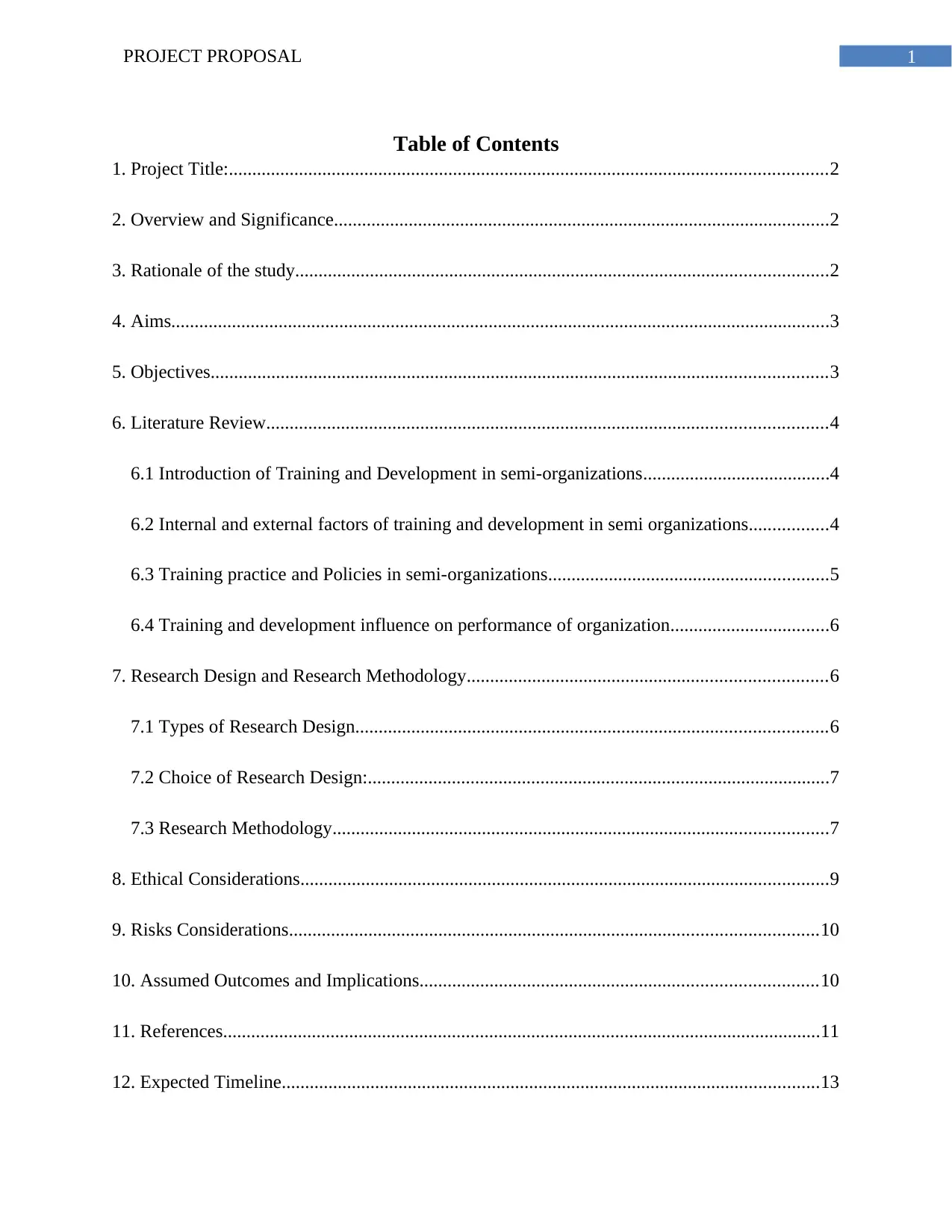
1PROJECT PROPOSAL
Table of Contents
1. Project Title:................................................................................................................................2
2. Overview and Significance..........................................................................................................2
3. Rationale of the study..................................................................................................................2
4. Aims.............................................................................................................................................3
5. Objectives....................................................................................................................................3
6. Literature Review........................................................................................................................4
6.1 Introduction of Training and Development in semi-organizations........................................4
6.2 Internal and external factors of training and development in semi organizations.................4
6.3 Training practice and Policies in semi-organizations............................................................5
6.4 Training and development influence on performance of organization..................................6
7. Research Design and Research Methodology.............................................................................6
7.1 Types of Research Design.....................................................................................................6
7.2 Choice of Research Design:...................................................................................................7
7.3 Research Methodology..........................................................................................................7
8. Ethical Considerations.................................................................................................................9
9. Risks Considerations.................................................................................................................10
10. Assumed Outcomes and Implications.....................................................................................10
11. References................................................................................................................................11
12. Expected Timeline...................................................................................................................13
Table of Contents
1. Project Title:................................................................................................................................2
2. Overview and Significance..........................................................................................................2
3. Rationale of the study..................................................................................................................2
4. Aims.............................................................................................................................................3
5. Objectives....................................................................................................................................3
6. Literature Review........................................................................................................................4
6.1 Introduction of Training and Development in semi-organizations........................................4
6.2 Internal and external factors of training and development in semi organizations.................4
6.3 Training practice and Policies in semi-organizations............................................................5
6.4 Training and development influence on performance of organization..................................6
7. Research Design and Research Methodology.............................................................................6
7.1 Types of Research Design.....................................................................................................6
7.2 Choice of Research Design:...................................................................................................7
7.3 Research Methodology..........................................................................................................7
8. Ethical Considerations.................................................................................................................9
9. Risks Considerations.................................................................................................................10
10. Assumed Outcomes and Implications.....................................................................................10
11. References................................................................................................................................11
12. Expected Timeline...................................................................................................................13
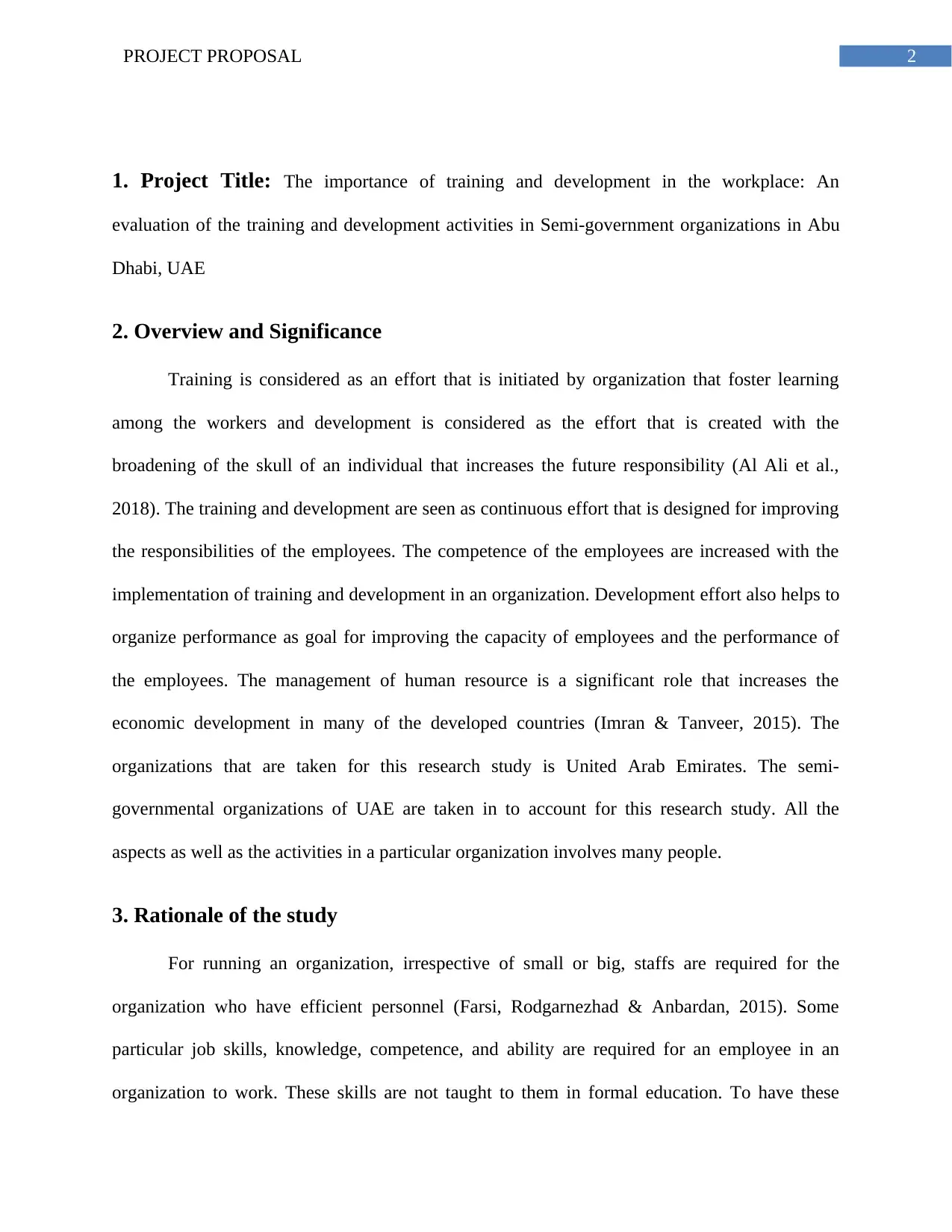
2PROJECT PROPOSAL
1. Project Title: The importance of training and development in the workplace: An
evaluation of the training and development activities in Semi-government organizations in Abu
Dhabi, UAE
2. Overview and Significance
Training is considered as an effort that is initiated by organization that foster learning
among the workers and development is considered as the effort that is created with the
broadening of the skull of an individual that increases the future responsibility (Al Ali et al.,
2018). The training and development are seen as continuous effort that is designed for improving
the responsibilities of the employees. The competence of the employees are increased with the
implementation of training and development in an organization. Development effort also helps to
organize performance as goal for improving the capacity of employees and the performance of
the employees. The management of human resource is a significant role that increases the
economic development in many of the developed countries (Imran & Tanveer, 2015). The
organizations that are taken for this research study is United Arab Emirates. The semi-
governmental organizations of UAE are taken in to account for this research study. All the
aspects as well as the activities in a particular organization involves many people.
3. Rationale of the study
For running an organization, irrespective of small or big, staffs are required for the
organization who have efficient personnel (Farsi, Rodgarnezhad & Anbardan, 2015). Some
particular job skills, knowledge, competence, and ability are required for an employee in an
organization to work. These skills are not taught to them in formal education. To have these
1. Project Title: The importance of training and development in the workplace: An
evaluation of the training and development activities in Semi-government organizations in Abu
Dhabi, UAE
2. Overview and Significance
Training is considered as an effort that is initiated by organization that foster learning
among the workers and development is considered as the effort that is created with the
broadening of the skull of an individual that increases the future responsibility (Al Ali et al.,
2018). The training and development are seen as continuous effort that is designed for improving
the responsibilities of the employees. The competence of the employees are increased with the
implementation of training and development in an organization. Development effort also helps to
organize performance as goal for improving the capacity of employees and the performance of
the employees. The management of human resource is a significant role that increases the
economic development in many of the developed countries (Imran & Tanveer, 2015). The
organizations that are taken for this research study is United Arab Emirates. The semi-
governmental organizations of UAE are taken in to account for this research study. All the
aspects as well as the activities in a particular organization involves many people.
3. Rationale of the study
For running an organization, irrespective of small or big, staffs are required for the
organization who have efficient personnel (Farsi, Rodgarnezhad & Anbardan, 2015). Some
particular job skills, knowledge, competence, and ability are required for an employee in an
organization to work. These skills are not taught to them in formal education. To have these
⊘ This is a preview!⊘
Do you want full access?
Subscribe today to unlock all pages.

Trusted by 1+ million students worldwide
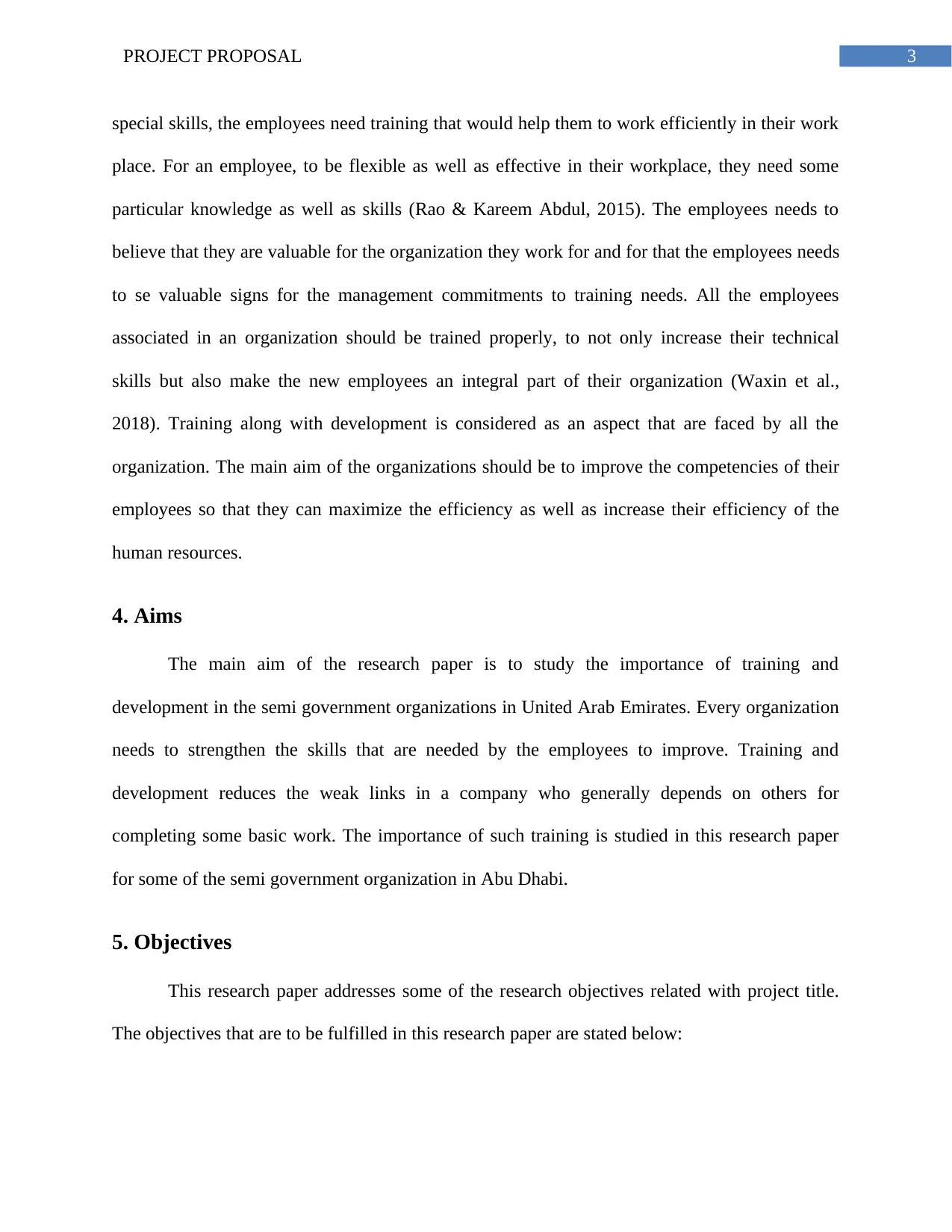
3PROJECT PROPOSAL
special skills, the employees need training that would help them to work efficiently in their work
place. For an employee, to be flexible as well as effective in their workplace, they need some
particular knowledge as well as skills (Rao & Kareem Abdul, 2015). The employees needs to
believe that they are valuable for the organization they work for and for that the employees needs
to se valuable signs for the management commitments to training needs. All the employees
associated in an organization should be trained properly, to not only increase their technical
skills but also make the new employees an integral part of their organization (Waxin et al.,
2018). Training along with development is considered as an aspect that are faced by all the
organization. The main aim of the organizations should be to improve the competencies of their
employees so that they can maximize the efficiency as well as increase their efficiency of the
human resources.
4. Aims
The main aim of the research paper is to study the importance of training and
development in the semi government organizations in United Arab Emirates. Every organization
needs to strengthen the skills that are needed by the employees to improve. Training and
development reduces the weak links in a company who generally depends on others for
completing some basic work. The importance of such training is studied in this research paper
for some of the semi government organization in Abu Dhabi.
5. Objectives
This research paper addresses some of the research objectives related with project title.
The objectives that are to be fulfilled in this research paper are stated below:
special skills, the employees need training that would help them to work efficiently in their work
place. For an employee, to be flexible as well as effective in their workplace, they need some
particular knowledge as well as skills (Rao & Kareem Abdul, 2015). The employees needs to
believe that they are valuable for the organization they work for and for that the employees needs
to se valuable signs for the management commitments to training needs. All the employees
associated in an organization should be trained properly, to not only increase their technical
skills but also make the new employees an integral part of their organization (Waxin et al.,
2018). Training along with development is considered as an aspect that are faced by all the
organization. The main aim of the organizations should be to improve the competencies of their
employees so that they can maximize the efficiency as well as increase their efficiency of the
human resources.
4. Aims
The main aim of the research paper is to study the importance of training and
development in the semi government organizations in United Arab Emirates. Every organization
needs to strengthen the skills that are needed by the employees to improve. Training and
development reduces the weak links in a company who generally depends on others for
completing some basic work. The importance of such training is studied in this research paper
for some of the semi government organization in Abu Dhabi.
5. Objectives
This research paper addresses some of the research objectives related with project title.
The objectives that are to be fulfilled in this research paper are stated below:
Paraphrase This Document
Need a fresh take? Get an instant paraphrase of this document with our AI Paraphraser
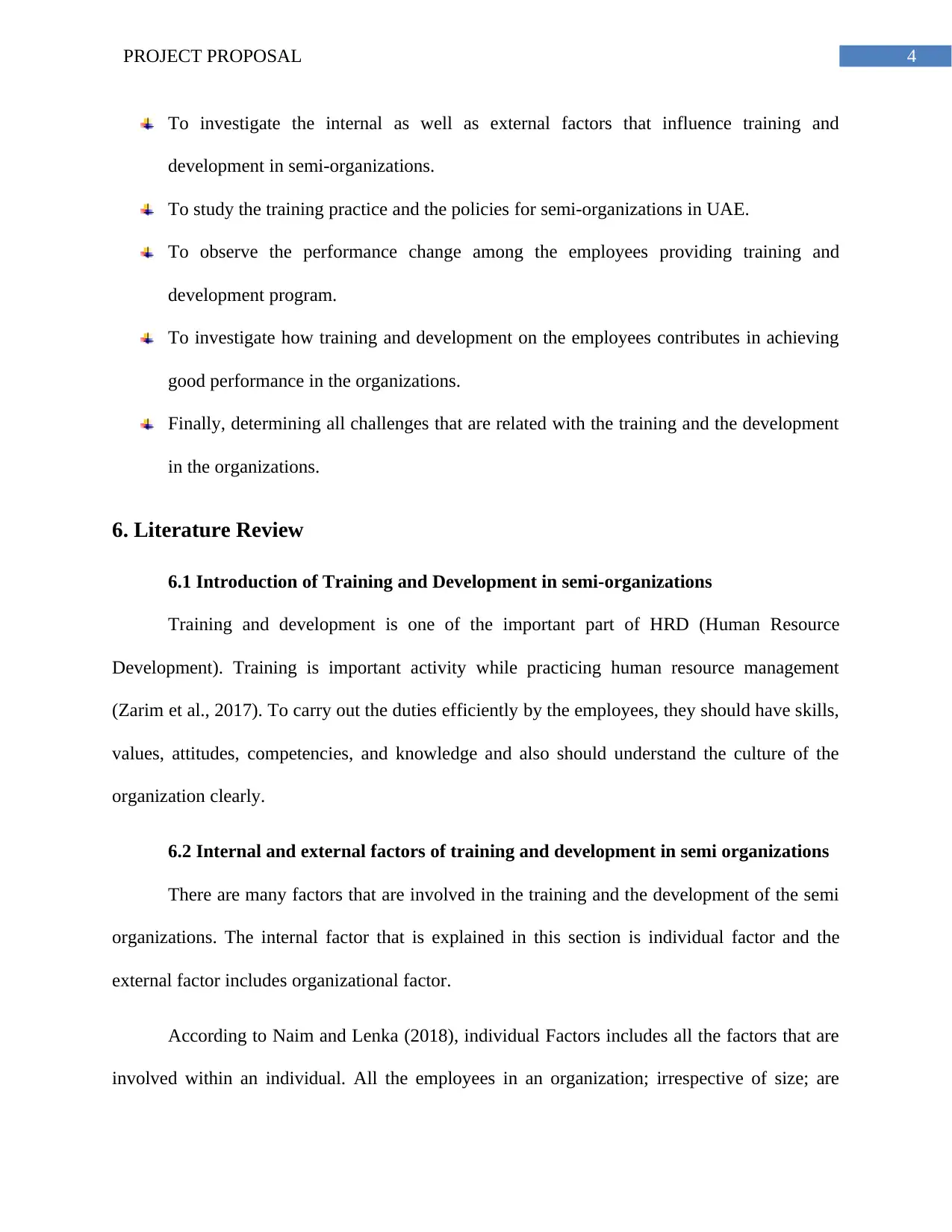
4PROJECT PROPOSAL
To investigate the internal as well as external factors that influence training and
development in semi-organizations.
To study the training practice and the policies for semi-organizations in UAE.
To observe the performance change among the employees providing training and
development program.
To investigate how training and development on the employees contributes in achieving
good performance in the organizations.
Finally, determining all challenges that are related with the training and the development
in the organizations.
6. Literature Review
6.1 Introduction of Training and Development in semi-organizations
Training and development is one of the important part of HRD (Human Resource
Development). Training is important activity while practicing human resource management
(Zarim et al., 2017). To carry out the duties efficiently by the employees, they should have skills,
values, attitudes, competencies, and knowledge and also should understand the culture of the
organization clearly.
6.2 Internal and external factors of training and development in semi organizations
There are many factors that are involved in the training and the development of the semi
organizations. The internal factor that is explained in this section is individual factor and the
external factor includes organizational factor.
According to Naim and Lenka (2018), individual Factors includes all the factors that are
involved within an individual. All the employees in an organization; irrespective of size; are
To investigate the internal as well as external factors that influence training and
development in semi-organizations.
To study the training practice and the policies for semi-organizations in UAE.
To observe the performance change among the employees providing training and
development program.
To investigate how training and development on the employees contributes in achieving
good performance in the organizations.
Finally, determining all challenges that are related with the training and the development
in the organizations.
6. Literature Review
6.1 Introduction of Training and Development in semi-organizations
Training and development is one of the important part of HRD (Human Resource
Development). Training is important activity while practicing human resource management
(Zarim et al., 2017). To carry out the duties efficiently by the employees, they should have skills,
values, attitudes, competencies, and knowledge and also should understand the culture of the
organization clearly.
6.2 Internal and external factors of training and development in semi organizations
There are many factors that are involved in the training and the development of the semi
organizations. The internal factor that is explained in this section is individual factor and the
external factor includes organizational factor.
According to Naim and Lenka (2018), individual Factors includes all the factors that are
involved within an individual. All the employees in an organization; irrespective of size; are
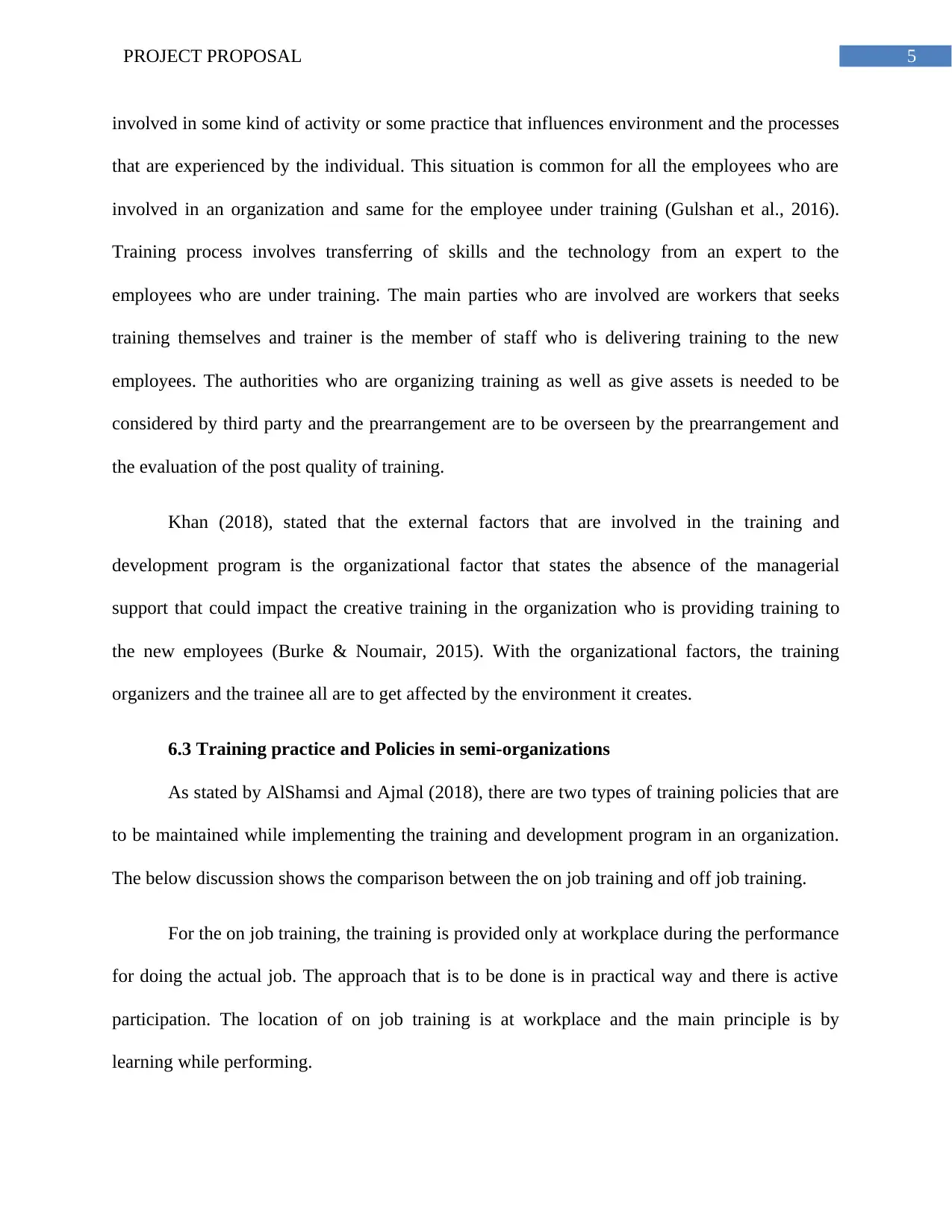
5PROJECT PROPOSAL
involved in some kind of activity or some practice that influences environment and the processes
that are experienced by the individual. This situation is common for all the employees who are
involved in an organization and same for the employee under training (Gulshan et al., 2016).
Training process involves transferring of skills and the technology from an expert to the
employees who are under training. The main parties who are involved are workers that seeks
training themselves and trainer is the member of staff who is delivering training to the new
employees. The authorities who are organizing training as well as give assets is needed to be
considered by third party and the prearrangement are to be overseen by the prearrangement and
the evaluation of the post quality of training.
Khan (2018), stated that the external factors that are involved in the training and
development program is the organizational factor that states the absence of the managerial
support that could impact the creative training in the organization who is providing training to
the new employees (Burke & Noumair, 2015). With the organizational factors, the training
organizers and the trainee all are to get affected by the environment it creates.
6.3 Training practice and Policies in semi-organizations
As stated by AlShamsi and Ajmal (2018), there are two types of training policies that are
to be maintained while implementing the training and development program in an organization.
The below discussion shows the comparison between the on job training and off job training.
For the on job training, the training is provided only at workplace during the performance
for doing the actual job. The approach that is to be done is in practical way and there is active
participation. The location of on job training is at workplace and the main principle is by
learning while performing.
involved in some kind of activity or some practice that influences environment and the processes
that are experienced by the individual. This situation is common for all the employees who are
involved in an organization and same for the employee under training (Gulshan et al., 2016).
Training process involves transferring of skills and the technology from an expert to the
employees who are under training. The main parties who are involved are workers that seeks
training themselves and trainer is the member of staff who is delivering training to the new
employees. The authorities who are organizing training as well as give assets is needed to be
considered by third party and the prearrangement are to be overseen by the prearrangement and
the evaluation of the post quality of training.
Khan (2018), stated that the external factors that are involved in the training and
development program is the organizational factor that states the absence of the managerial
support that could impact the creative training in the organization who is providing training to
the new employees (Burke & Noumair, 2015). With the organizational factors, the training
organizers and the trainee all are to get affected by the environment it creates.
6.3 Training practice and Policies in semi-organizations
As stated by AlShamsi and Ajmal (2018), there are two types of training policies that are
to be maintained while implementing the training and development program in an organization.
The below discussion shows the comparison between the on job training and off job training.
For the on job training, the training is provided only at workplace during the performance
for doing the actual job. The approach that is to be done is in practical way and there is active
participation. The location of on job training is at workplace and the main principle is by
learning while performing.
⊘ This is a preview!⊘
Do you want full access?
Subscribe today to unlock all pages.

Trusted by 1+ million students worldwide
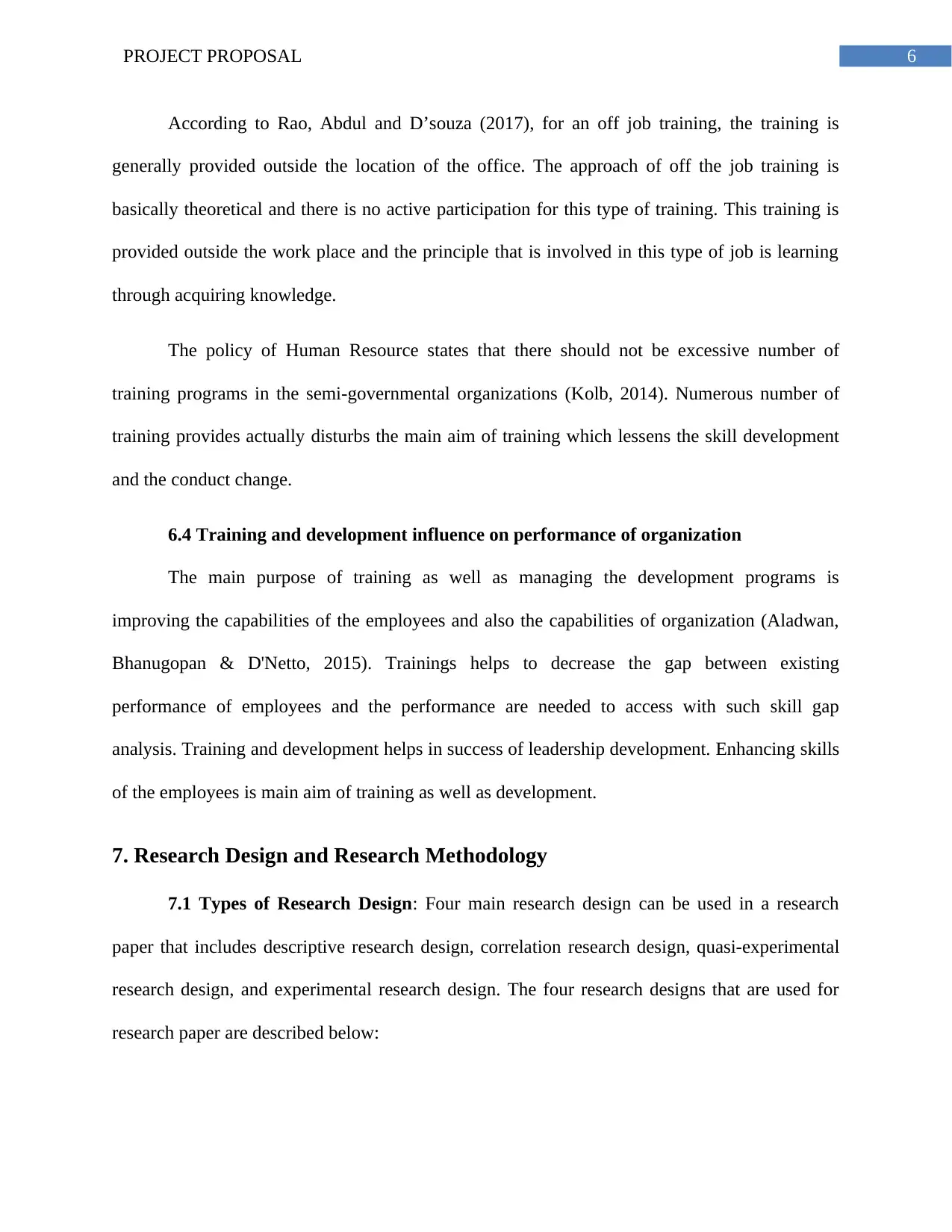
6PROJECT PROPOSAL
According to Rao, Abdul and D’souza (2017), for an off job training, the training is
generally provided outside the location of the office. The approach of off the job training is
basically theoretical and there is no active participation for this type of training. This training is
provided outside the work place and the principle that is involved in this type of job is learning
through acquiring knowledge.
The policy of Human Resource states that there should not be excessive number of
training programs in the semi-governmental organizations (Kolb, 2014). Numerous number of
training provides actually disturbs the main aim of training which lessens the skill development
and the conduct change.
6.4 Training and development influence on performance of organization
The main purpose of training as well as managing the development programs is
improving the capabilities of the employees and also the capabilities of organization (Aladwan,
Bhanugopan & D'Netto, 2015). Trainings helps to decrease the gap between existing
performance of employees and the performance are needed to access with such skill gap
analysis. Training and development helps in success of leadership development. Enhancing skills
of the employees is main aim of training as well as development.
7. Research Design and Research Methodology
7.1 Types of Research Design: Four main research design can be used in a research
paper that includes descriptive research design, correlation research design, quasi-experimental
research design, and experimental research design. The four research designs that are used for
research paper are described below:
According to Rao, Abdul and D’souza (2017), for an off job training, the training is
generally provided outside the location of the office. The approach of off the job training is
basically theoretical and there is no active participation for this type of training. This training is
provided outside the work place and the principle that is involved in this type of job is learning
through acquiring knowledge.
The policy of Human Resource states that there should not be excessive number of
training programs in the semi-governmental organizations (Kolb, 2014). Numerous number of
training provides actually disturbs the main aim of training which lessens the skill development
and the conduct change.
6.4 Training and development influence on performance of organization
The main purpose of training as well as managing the development programs is
improving the capabilities of the employees and also the capabilities of organization (Aladwan,
Bhanugopan & D'Netto, 2015). Trainings helps to decrease the gap between existing
performance of employees and the performance are needed to access with such skill gap
analysis. Training and development helps in success of leadership development. Enhancing skills
of the employees is main aim of training as well as development.
7. Research Design and Research Methodology
7.1 Types of Research Design: Four main research design can be used in a research
paper that includes descriptive research design, correlation research design, quasi-experimental
research design, and experimental research design. The four research designs that are used for
research paper are described below:
Paraphrase This Document
Need a fresh take? Get an instant paraphrase of this document with our AI Paraphraser
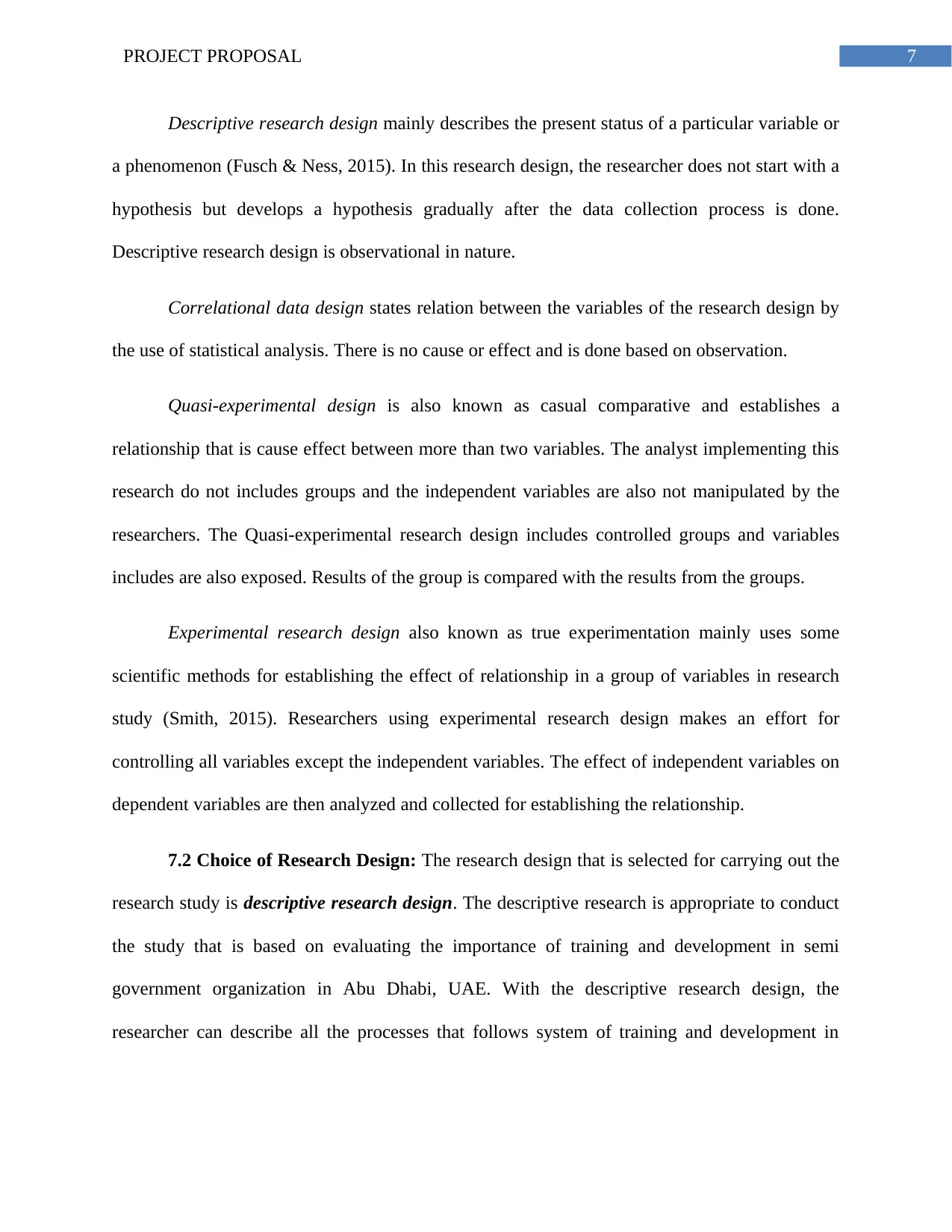
7PROJECT PROPOSAL
Descriptive research design mainly describes the present status of a particular variable or
a phenomenon (Fusch & Ness, 2015). In this research design, the researcher does not start with a
hypothesis but develops a hypothesis gradually after the data collection process is done.
Descriptive research design is observational in nature.
Correlational data design states relation between the variables of the research design by
the use of statistical analysis. There is no cause or effect and is done based on observation.
Quasi-experimental design is also known as casual comparative and establishes a
relationship that is cause effect between more than two variables. The analyst implementing this
research do not includes groups and the independent variables are also not manipulated by the
researchers. The Quasi-experimental research design includes controlled groups and variables
includes are also exposed. Results of the group is compared with the results from the groups.
Experimental research design also known as true experimentation mainly uses some
scientific methods for establishing the effect of relationship in a group of variables in research
study (Smith, 2015). Researchers using experimental research design makes an effort for
controlling all variables except the independent variables. The effect of independent variables on
dependent variables are then analyzed and collected for establishing the relationship.
7.2 Choice of Research Design: The research design that is selected for carrying out the
research study is descriptive research design. The descriptive research is appropriate to conduct
the study that is based on evaluating the importance of training and development in semi
government organization in Abu Dhabi, UAE. With the descriptive research design, the
researcher can describe all the processes that follows system of training and development in
Descriptive research design mainly describes the present status of a particular variable or
a phenomenon (Fusch & Ness, 2015). In this research design, the researcher does not start with a
hypothesis but develops a hypothesis gradually after the data collection process is done.
Descriptive research design is observational in nature.
Correlational data design states relation between the variables of the research design by
the use of statistical analysis. There is no cause or effect and is done based on observation.
Quasi-experimental design is also known as casual comparative and establishes a
relationship that is cause effect between more than two variables. The analyst implementing this
research do not includes groups and the independent variables are also not manipulated by the
researchers. The Quasi-experimental research design includes controlled groups and variables
includes are also exposed. Results of the group is compared with the results from the groups.
Experimental research design also known as true experimentation mainly uses some
scientific methods for establishing the effect of relationship in a group of variables in research
study (Smith, 2015). Researchers using experimental research design makes an effort for
controlling all variables except the independent variables. The effect of independent variables on
dependent variables are then analyzed and collected for establishing the relationship.
7.2 Choice of Research Design: The research design that is selected for carrying out the
research study is descriptive research design. The descriptive research is appropriate to conduct
the study that is based on evaluating the importance of training and development in semi
government organization in Abu Dhabi, UAE. With the descriptive research design, the
researcher can describe all the processes that follows system of training and development in
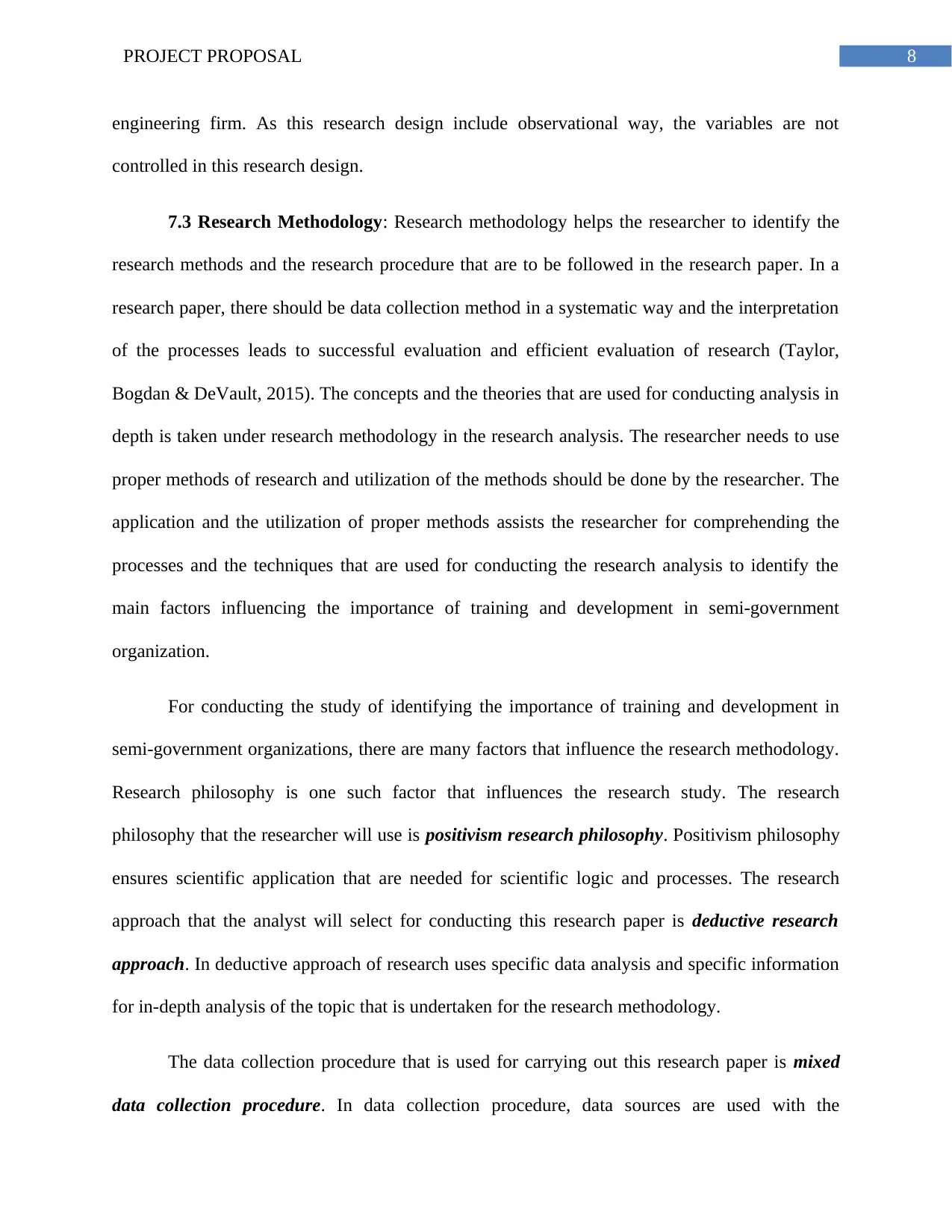
8PROJECT PROPOSAL
engineering firm. As this research design include observational way, the variables are not
controlled in this research design.
7.3 Research Methodology: Research methodology helps the researcher to identify the
research methods and the research procedure that are to be followed in the research paper. In a
research paper, there should be data collection method in a systematic way and the interpretation
of the processes leads to successful evaluation and efficient evaluation of research (Taylor,
Bogdan & DeVault, 2015). The concepts and the theories that are used for conducting analysis in
depth is taken under research methodology in the research analysis. The researcher needs to use
proper methods of research and utilization of the methods should be done by the researcher. The
application and the utilization of proper methods assists the researcher for comprehending the
processes and the techniques that are used for conducting the research analysis to identify the
main factors influencing the importance of training and development in semi-government
organization.
For conducting the study of identifying the importance of training and development in
semi-government organizations, there are many factors that influence the research methodology.
Research philosophy is one such factor that influences the research study. The research
philosophy that the researcher will use is positivism research philosophy. Positivism philosophy
ensures scientific application that are needed for scientific logic and processes. The research
approach that the analyst will select for conducting this research paper is deductive research
approach. In deductive approach of research uses specific data analysis and specific information
for in-depth analysis of the topic that is undertaken for the research methodology.
The data collection procedure that is used for carrying out this research paper is mixed
data collection procedure. In data collection procedure, data sources are used with the
engineering firm. As this research design include observational way, the variables are not
controlled in this research design.
7.3 Research Methodology: Research methodology helps the researcher to identify the
research methods and the research procedure that are to be followed in the research paper. In a
research paper, there should be data collection method in a systematic way and the interpretation
of the processes leads to successful evaluation and efficient evaluation of research (Taylor,
Bogdan & DeVault, 2015). The concepts and the theories that are used for conducting analysis in
depth is taken under research methodology in the research analysis. The researcher needs to use
proper methods of research and utilization of the methods should be done by the researcher. The
application and the utilization of proper methods assists the researcher for comprehending the
processes and the techniques that are used for conducting the research analysis to identify the
main factors influencing the importance of training and development in semi-government
organization.
For conducting the study of identifying the importance of training and development in
semi-government organizations, there are many factors that influence the research methodology.
Research philosophy is one such factor that influences the research study. The research
philosophy that the researcher will use is positivism research philosophy. Positivism philosophy
ensures scientific application that are needed for scientific logic and processes. The research
approach that the analyst will select for conducting this research paper is deductive research
approach. In deductive approach of research uses specific data analysis and specific information
for in-depth analysis of the topic that is undertaken for the research methodology.
The data collection procedure that is used for carrying out this research paper is mixed
data collection procedure. In data collection procedure, data sources are used with the
⊘ This is a preview!⊘
Do you want full access?
Subscribe today to unlock all pages.

Trusted by 1+ million students worldwide
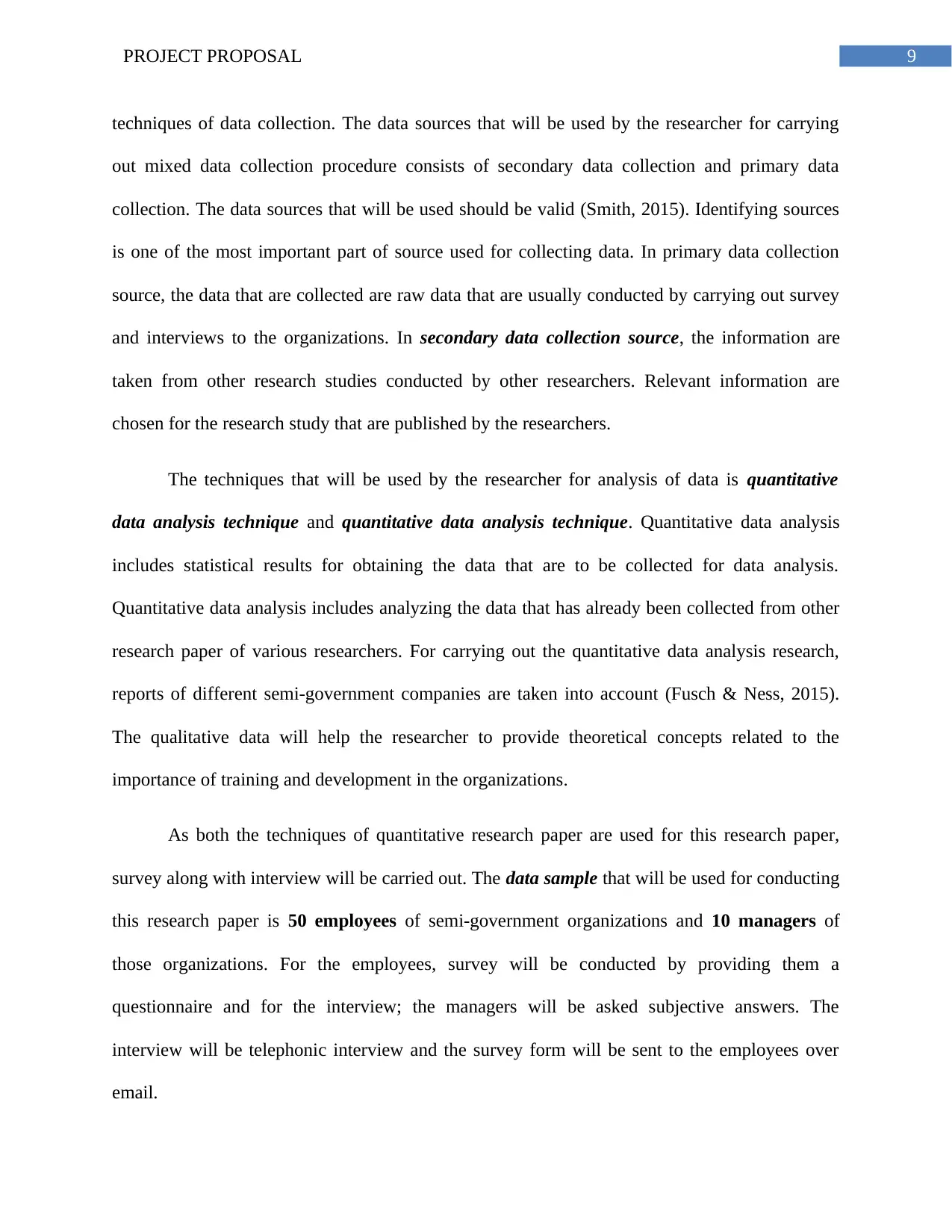
9PROJECT PROPOSAL
techniques of data collection. The data sources that will be used by the researcher for carrying
out mixed data collection procedure consists of secondary data collection and primary data
collection. The data sources that will be used should be valid (Smith, 2015). Identifying sources
is one of the most important part of source used for collecting data. In primary data collection
source, the data that are collected are raw data that are usually conducted by carrying out survey
and interviews to the organizations. In secondary data collection source, the information are
taken from other research studies conducted by other researchers. Relevant information are
chosen for the research study that are published by the researchers.
The techniques that will be used by the researcher for analysis of data is quantitative
data analysis technique and quantitative data analysis technique. Quantitative data analysis
includes statistical results for obtaining the data that are to be collected for data analysis.
Quantitative data analysis includes analyzing the data that has already been collected from other
research paper of various researchers. For carrying out the quantitative data analysis research,
reports of different semi-government companies are taken into account (Fusch & Ness, 2015).
The qualitative data will help the researcher to provide theoretical concepts related to the
importance of training and development in the organizations.
As both the techniques of quantitative research paper are used for this research paper,
survey along with interview will be carried out. The data sample that will be used for conducting
this research paper is 50 employees of semi-government organizations and 10 managers of
those organizations. For the employees, survey will be conducted by providing them a
questionnaire and for the interview; the managers will be asked subjective answers. The
interview will be telephonic interview and the survey form will be sent to the employees over
email.
techniques of data collection. The data sources that will be used by the researcher for carrying
out mixed data collection procedure consists of secondary data collection and primary data
collection. The data sources that will be used should be valid (Smith, 2015). Identifying sources
is one of the most important part of source used for collecting data. In primary data collection
source, the data that are collected are raw data that are usually conducted by carrying out survey
and interviews to the organizations. In secondary data collection source, the information are
taken from other research studies conducted by other researchers. Relevant information are
chosen for the research study that are published by the researchers.
The techniques that will be used by the researcher for analysis of data is quantitative
data analysis technique and quantitative data analysis technique. Quantitative data analysis
includes statistical results for obtaining the data that are to be collected for data analysis.
Quantitative data analysis includes analyzing the data that has already been collected from other
research paper of various researchers. For carrying out the quantitative data analysis research,
reports of different semi-government companies are taken into account (Fusch & Ness, 2015).
The qualitative data will help the researcher to provide theoretical concepts related to the
importance of training and development in the organizations.
As both the techniques of quantitative research paper are used for this research paper,
survey along with interview will be carried out. The data sample that will be used for conducting
this research paper is 50 employees of semi-government organizations and 10 managers of
those organizations. For the employees, survey will be conducted by providing them a
questionnaire and for the interview; the managers will be asked subjective answers. The
interview will be telephonic interview and the survey form will be sent to the employees over
email.
Paraphrase This Document
Need a fresh take? Get an instant paraphrase of this document with our AI Paraphraser
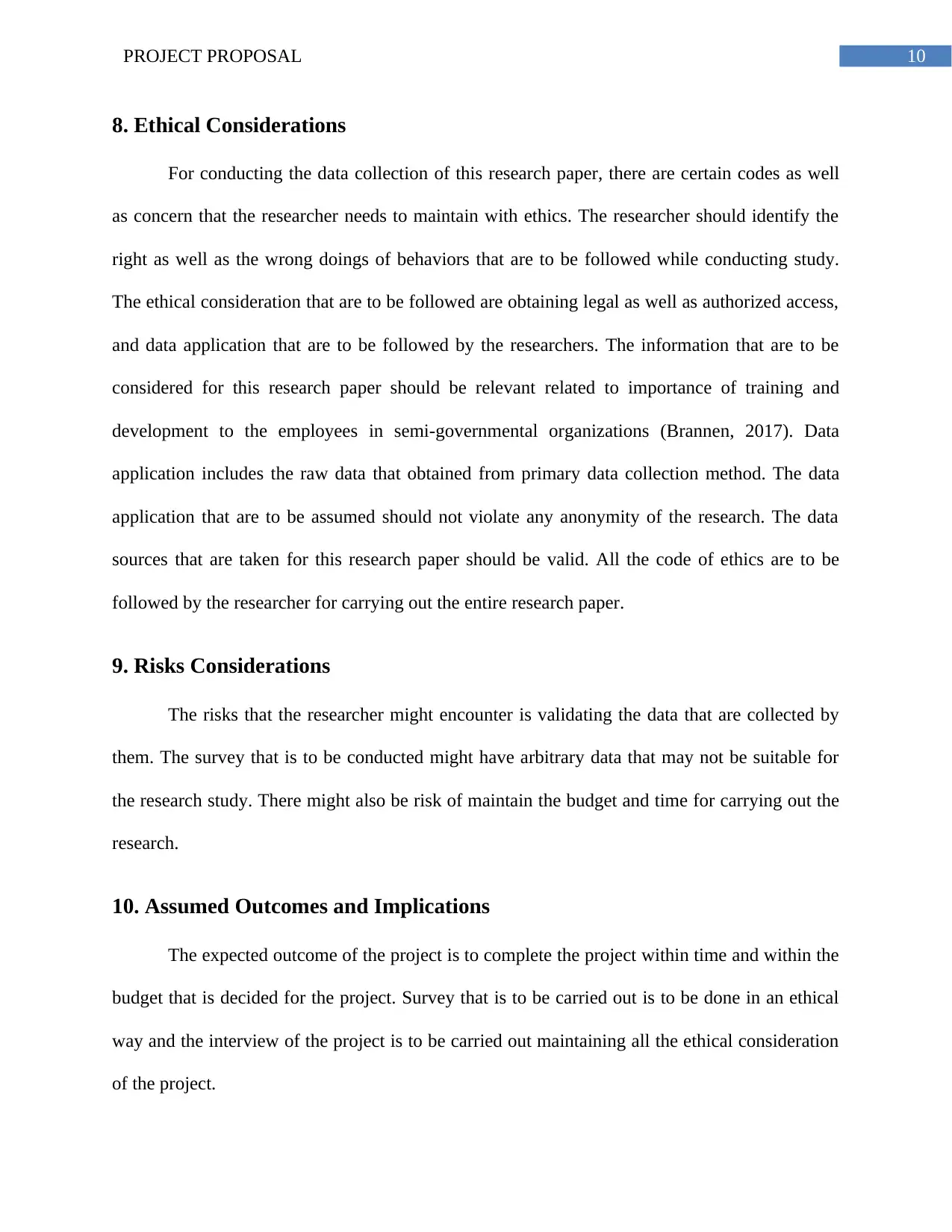
10PROJECT PROPOSAL
8. Ethical Considerations
For conducting the data collection of this research paper, there are certain codes as well
as concern that the researcher needs to maintain with ethics. The researcher should identify the
right as well as the wrong doings of behaviors that are to be followed while conducting study.
The ethical consideration that are to be followed are obtaining legal as well as authorized access,
and data application that are to be followed by the researchers. The information that are to be
considered for this research paper should be relevant related to importance of training and
development to the employees in semi-governmental organizations (Brannen, 2017). Data
application includes the raw data that obtained from primary data collection method. The data
application that are to be assumed should not violate any anonymity of the research. The data
sources that are taken for this research paper should be valid. All the code of ethics are to be
followed by the researcher for carrying out the entire research paper.
9. Risks Considerations
The risks that the researcher might encounter is validating the data that are collected by
them. The survey that is to be conducted might have arbitrary data that may not be suitable for
the research study. There might also be risk of maintain the budget and time for carrying out the
research.
10. Assumed Outcomes and Implications
The expected outcome of the project is to complete the project within time and within the
budget that is decided for the project. Survey that is to be carried out is to be done in an ethical
way and the interview of the project is to be carried out maintaining all the ethical consideration
of the project.
8. Ethical Considerations
For conducting the data collection of this research paper, there are certain codes as well
as concern that the researcher needs to maintain with ethics. The researcher should identify the
right as well as the wrong doings of behaviors that are to be followed while conducting study.
The ethical consideration that are to be followed are obtaining legal as well as authorized access,
and data application that are to be followed by the researchers. The information that are to be
considered for this research paper should be relevant related to importance of training and
development to the employees in semi-governmental organizations (Brannen, 2017). Data
application includes the raw data that obtained from primary data collection method. The data
application that are to be assumed should not violate any anonymity of the research. The data
sources that are taken for this research paper should be valid. All the code of ethics are to be
followed by the researcher for carrying out the entire research paper.
9. Risks Considerations
The risks that the researcher might encounter is validating the data that are collected by
them. The survey that is to be conducted might have arbitrary data that may not be suitable for
the research study. There might also be risk of maintain the budget and time for carrying out the
research.
10. Assumed Outcomes and Implications
The expected outcome of the project is to complete the project within time and within the
budget that is decided for the project. Survey that is to be carried out is to be done in an ethical
way and the interview of the project is to be carried out maintaining all the ethical consideration
of the project.
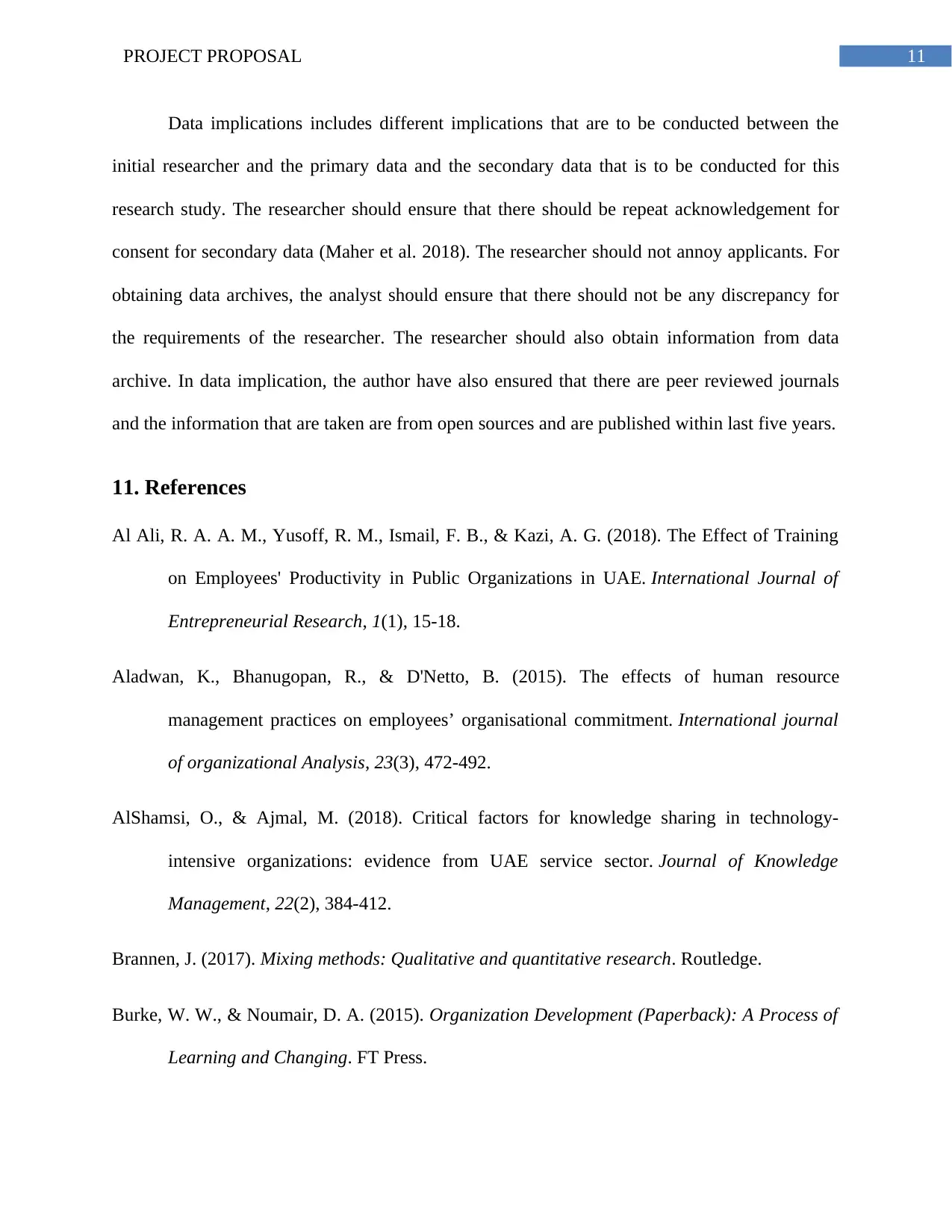
11PROJECT PROPOSAL
Data implications includes different implications that are to be conducted between the
initial researcher and the primary data and the secondary data that is to be conducted for this
research study. The researcher should ensure that there should be repeat acknowledgement for
consent for secondary data (Maher et al. 2018). The researcher should not annoy applicants. For
obtaining data archives, the analyst should ensure that there should not be any discrepancy for
the requirements of the researcher. The researcher should also obtain information from data
archive. In data implication, the author have also ensured that there are peer reviewed journals
and the information that are taken are from open sources and are published within last five years.
11. References
Al Ali, R. A. A. M., Yusoff, R. M., Ismail, F. B., & Kazi, A. G. (2018). The Effect of Training
on Employees' Productivity in Public Organizations in UAE. International Journal of
Entrepreneurial Research, 1(1), 15-18.
Aladwan, K., Bhanugopan, R., & D'Netto, B. (2015). The effects of human resource
management practices on employees’ organisational commitment. International journal
of organizational Analysis, 23(3), 472-492.
AlShamsi, O., & Ajmal, M. (2018). Critical factors for knowledge sharing in technology-
intensive organizations: evidence from UAE service sector. Journal of Knowledge
Management, 22(2), 384-412.
Brannen, J. (2017). Mixing methods: Qualitative and quantitative research. Routledge.
Burke, W. W., & Noumair, D. A. (2015). Organization Development (Paperback): A Process of
Learning and Changing. FT Press.
Data implications includes different implications that are to be conducted between the
initial researcher and the primary data and the secondary data that is to be conducted for this
research study. The researcher should ensure that there should be repeat acknowledgement for
consent for secondary data (Maher et al. 2018). The researcher should not annoy applicants. For
obtaining data archives, the analyst should ensure that there should not be any discrepancy for
the requirements of the researcher. The researcher should also obtain information from data
archive. In data implication, the author have also ensured that there are peer reviewed journals
and the information that are taken are from open sources and are published within last five years.
11. References
Al Ali, R. A. A. M., Yusoff, R. M., Ismail, F. B., & Kazi, A. G. (2018). The Effect of Training
on Employees' Productivity in Public Organizations in UAE. International Journal of
Entrepreneurial Research, 1(1), 15-18.
Aladwan, K., Bhanugopan, R., & D'Netto, B. (2015). The effects of human resource
management practices on employees’ organisational commitment. International journal
of organizational Analysis, 23(3), 472-492.
AlShamsi, O., & Ajmal, M. (2018). Critical factors for knowledge sharing in technology-
intensive organizations: evidence from UAE service sector. Journal of Knowledge
Management, 22(2), 384-412.
Brannen, J. (2017). Mixing methods: Qualitative and quantitative research. Routledge.
Burke, W. W., & Noumair, D. A. (2015). Organization Development (Paperback): A Process of
Learning and Changing. FT Press.
⊘ This is a preview!⊘
Do you want full access?
Subscribe today to unlock all pages.

Trusted by 1+ million students worldwide
1 out of 17
Related Documents
Your All-in-One AI-Powered Toolkit for Academic Success.
+13062052269
info@desklib.com
Available 24*7 on WhatsApp / Email
![[object Object]](/_next/static/media/star-bottom.7253800d.svg)
Unlock your academic potential
Copyright © 2020–2025 A2Z Services. All Rights Reserved. Developed and managed by ZUCOL.





